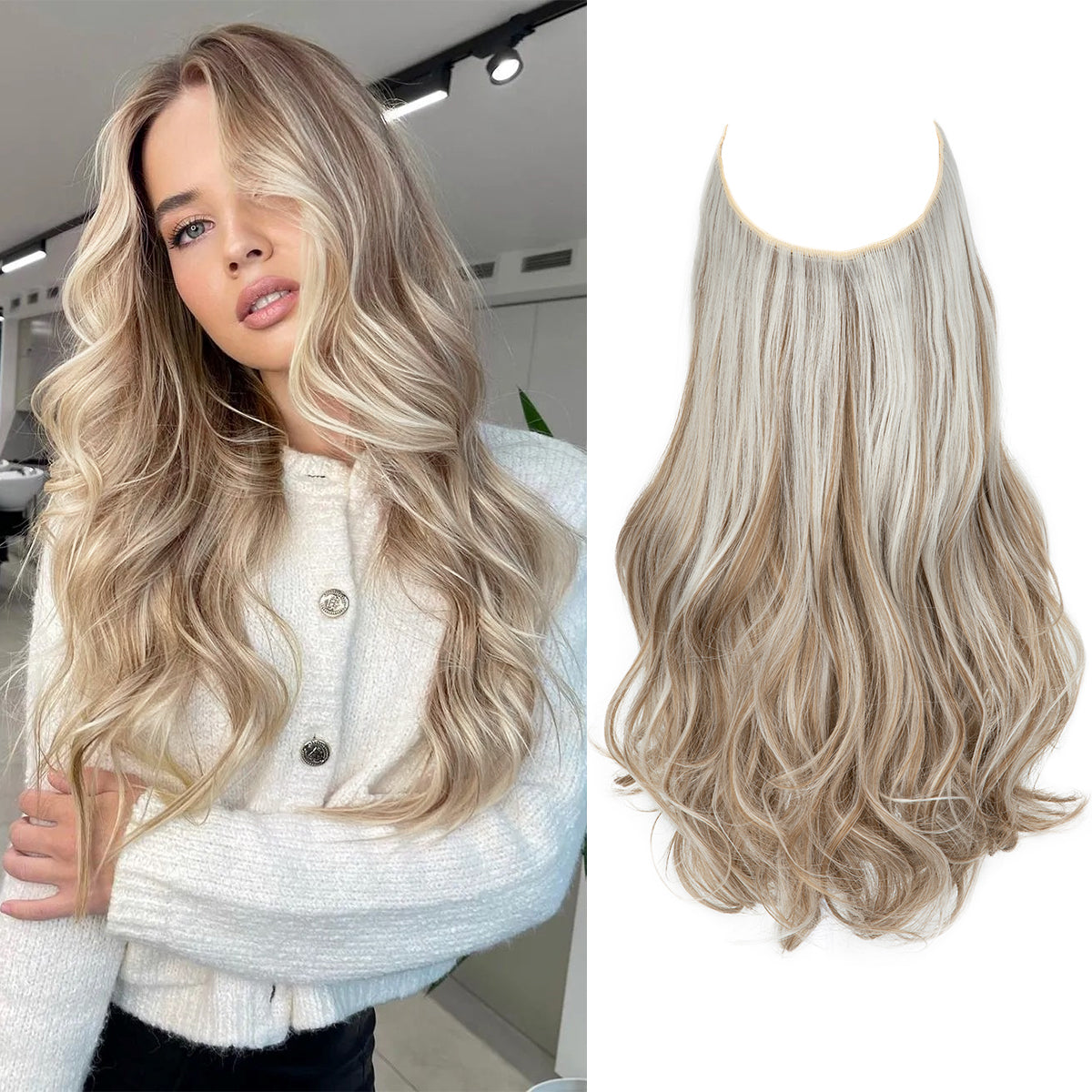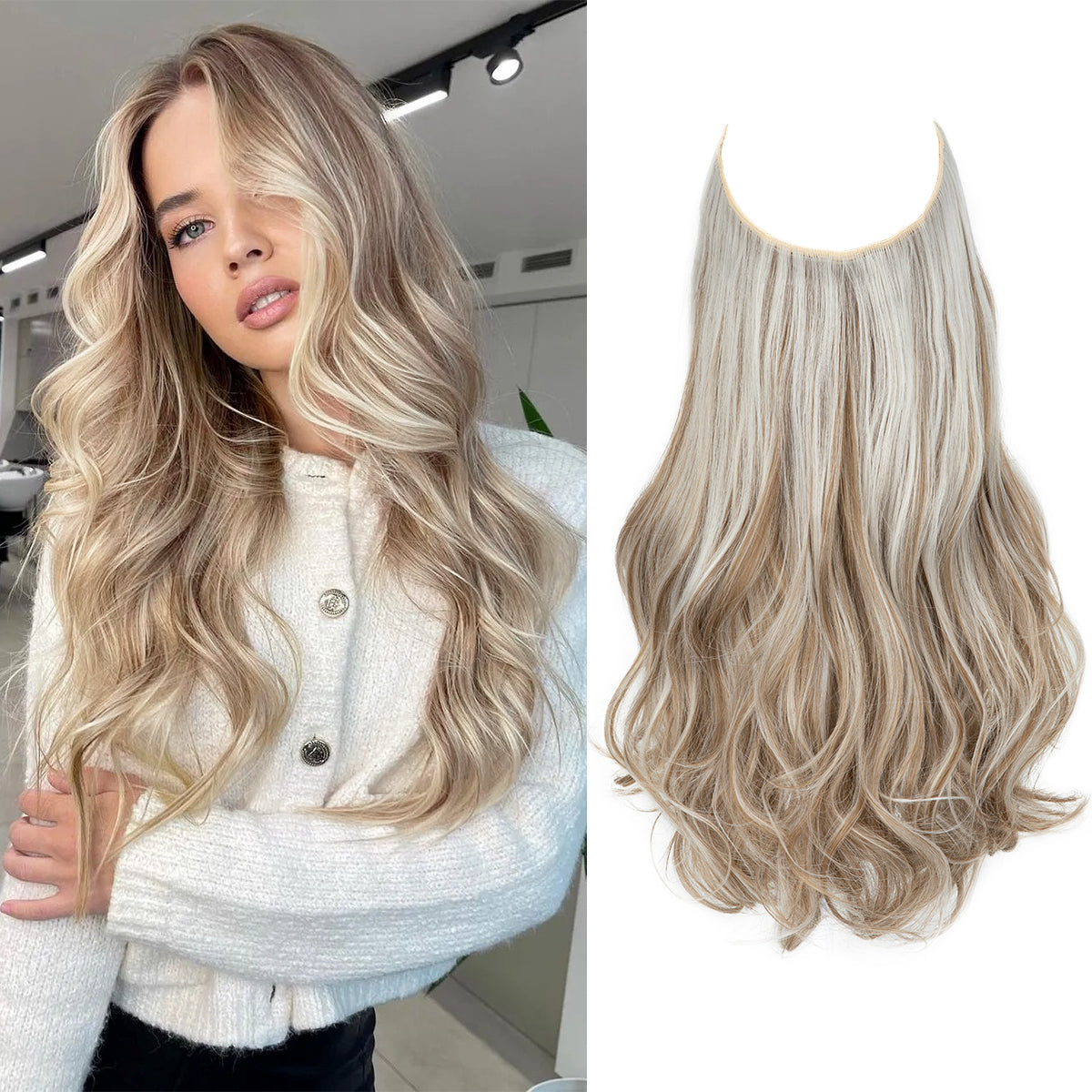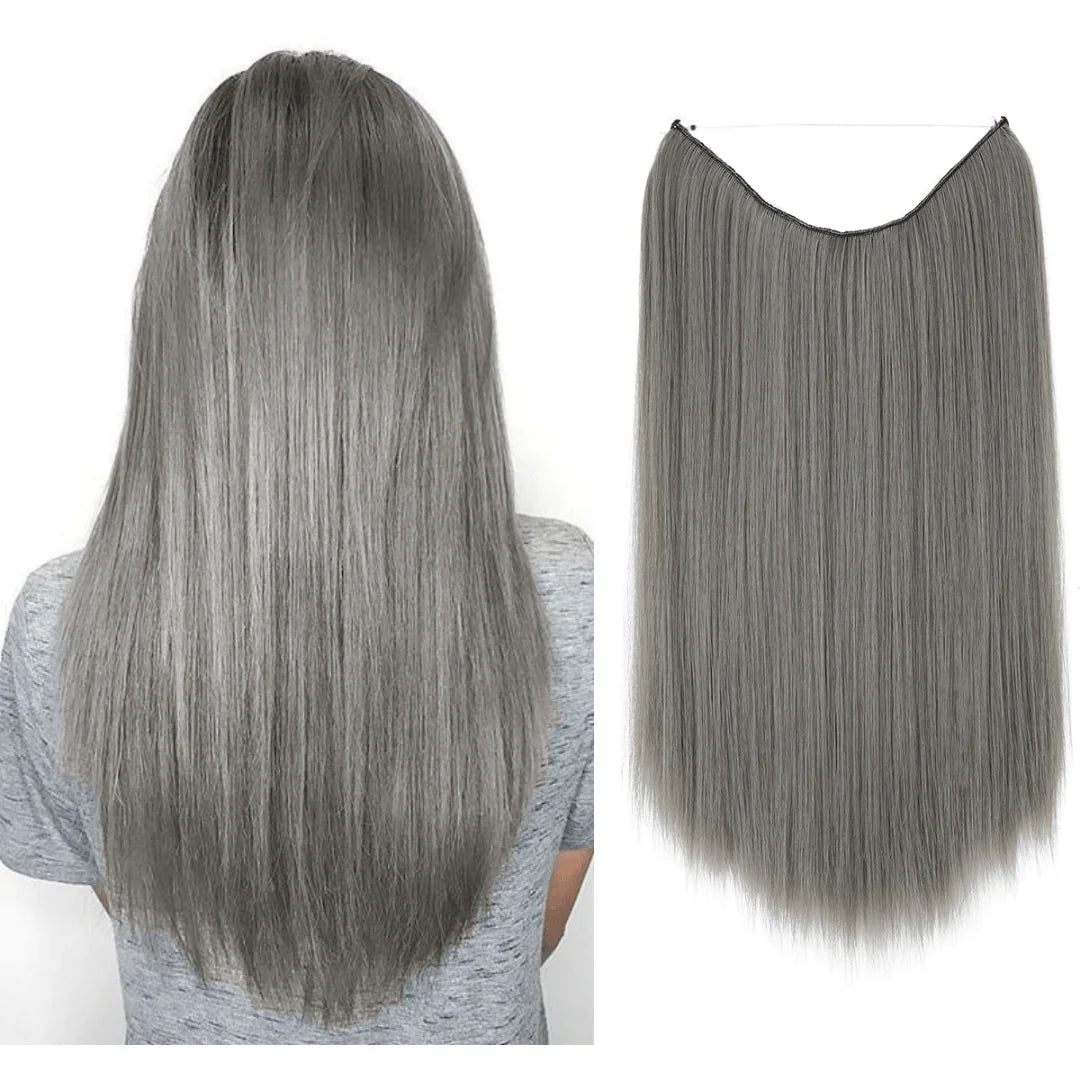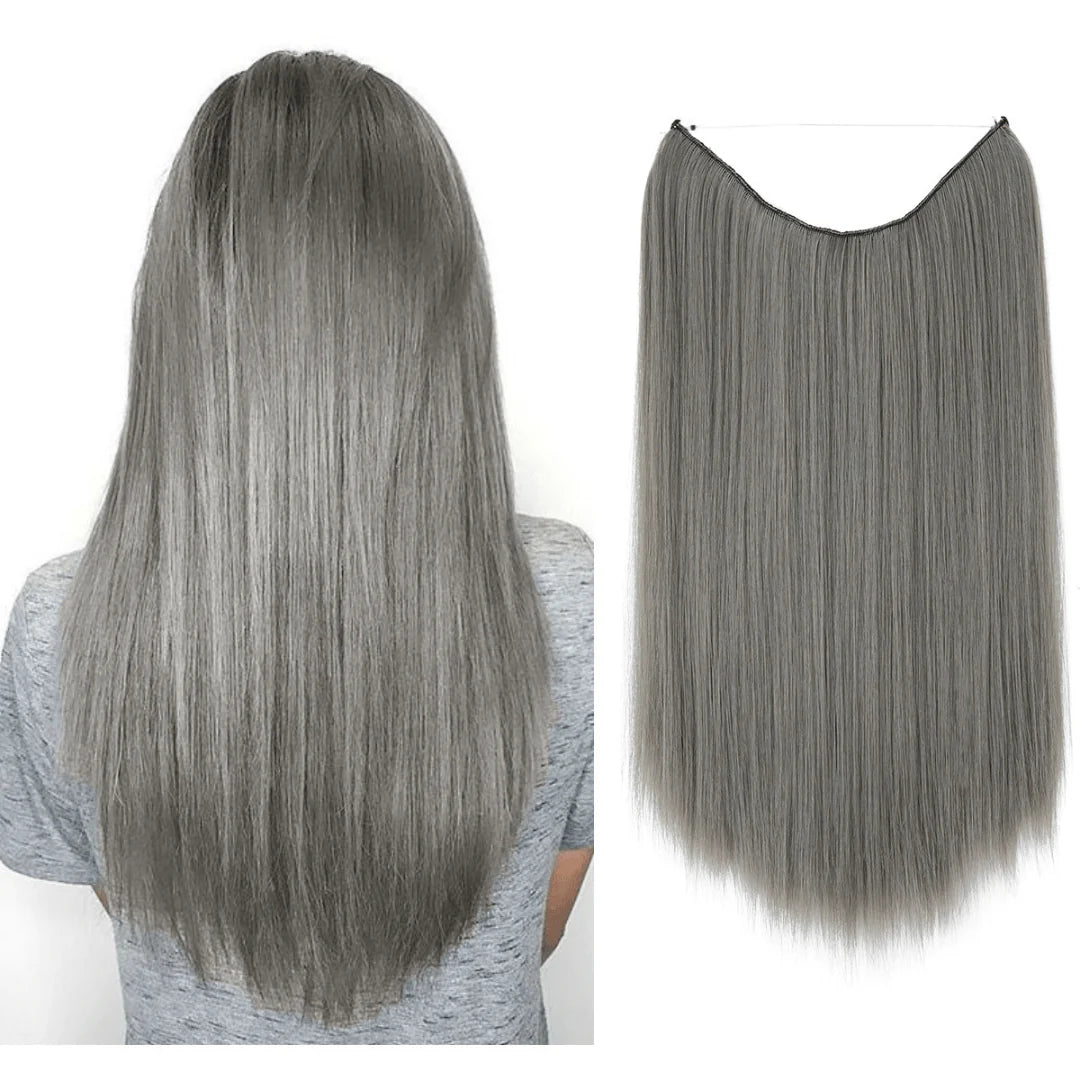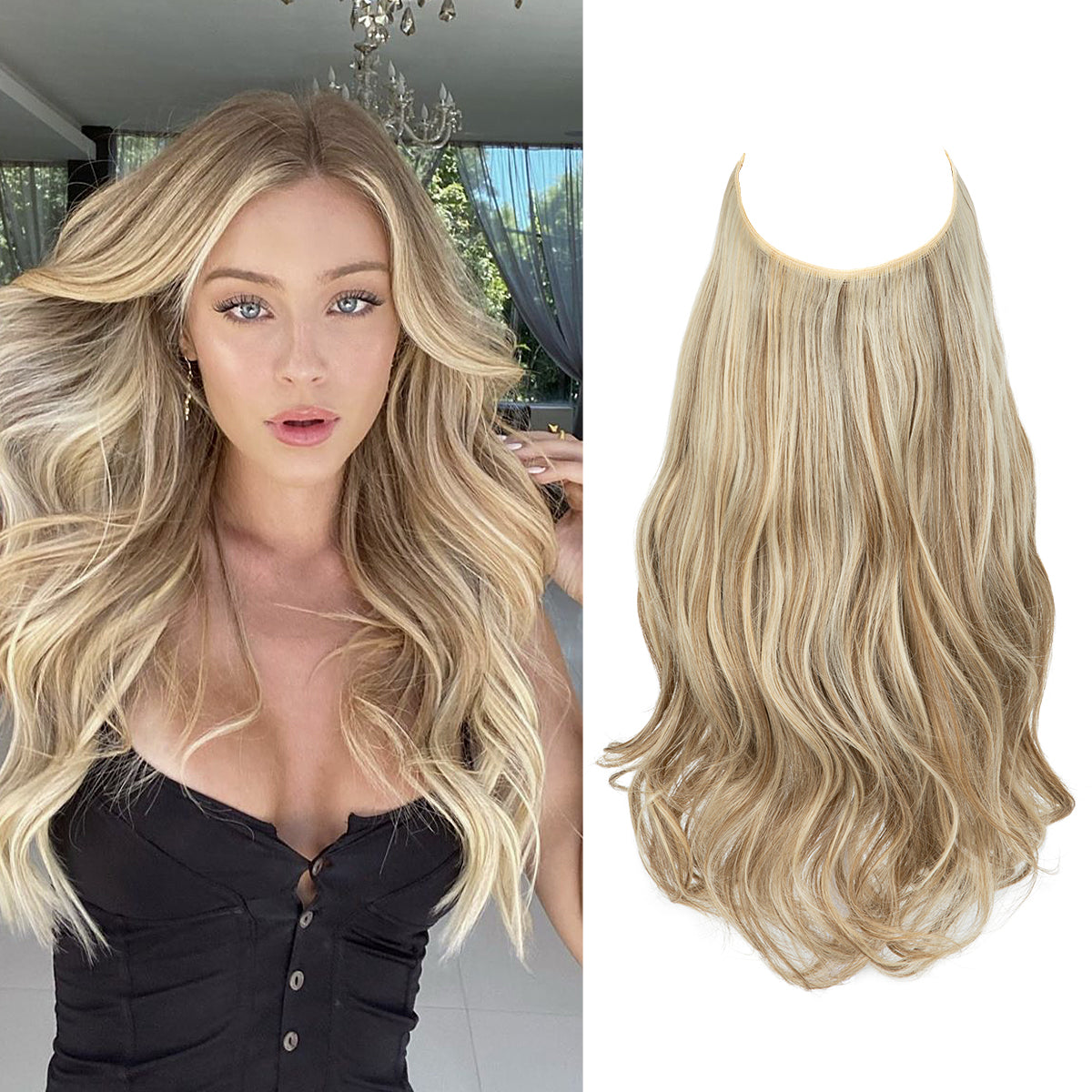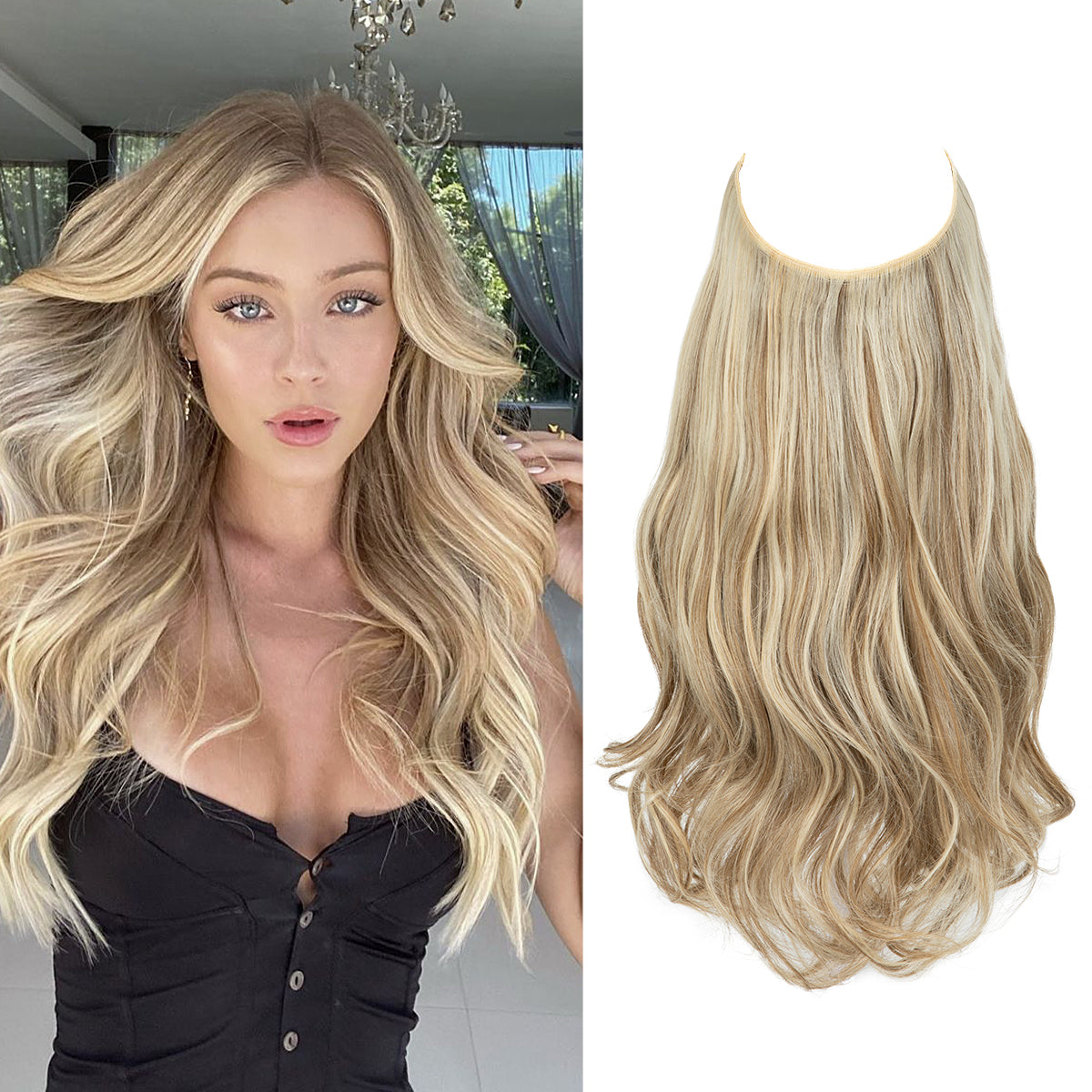
People who have short hair often wonder if halo extensions will suit their hairstyle. You are among many people who experience this uncertainty. The selection process for the right length becomes complicated because of the numerous available options. But the search for your ideal match should not be complicated.
Our purpose is to guide you through this process and assist you in selecting halo extension lengths that match your hair type, your height, and your desired style outcome. Will show you which errors to prevent when selecting halo extensions to avoid noticeable mismatches. Let’s dive in.
Understanding Halo Extension Length Measurements
When it comes to choosing the right halo hair extension, knowing how length is measured—and how it actually looks when worn—is key. Let’s walk through it in the simplest way possible.
Standard Length Range: 12" to 30"
Halo hair extensions typically range from 12 inches to 30 inches. Here's what those lengths usually mean when worn:
- 14 inch hair – Just below the shoulders
- 16 inch hair – Around mid-bust
- 18 inch hair – A few inches below the bust (our most popular length)
- 22 inch hair – Around the waist
- 30 inch hair – Falls past the hips for a long, flowing look
Keep in mind, your height and natural hair type will affect where the extensions fall. Taller individuals may find that the same length looks slightly shorter on them.
How Extension Length is Measured
All extensions are measured when the hair is straight. That means even if you're buying curly, wavy, or coily extensions, the listed length reflects the hair in its stretched-out form, not how it will appear once worn.
So, if you're eyeing a 20-inch curly halo, the hair might appear more like 16 to 18 inches when in its natural curl pattern. The tighter the curl, the more it shrinks in length.
Straight vs. Curly: What You Need to Know
Different curl patterns create different visual lengths. Here’s a quick chart to show how a given extension length looks across various hair types:
| Inches | Straight Hair | Wavy Hair | Curly Hair | Coily Hair |
|---|---|---|---|---|
| 14" | Shoulders | Chin | Below ear | Ear level |
| 16" | Bra strap | Upper back | Shoulders | Chin |
| 18" | Mid-back | Shoulder blades | Bra strap | Upper back |
| 22" | Lower back | Mid-back | Mid-back | Shoulder blades |
Tip: If you're going for waves, curls, or coils, always size up to get the look you want.
| Halo | Clip-in | Glue/Tape-in | Sew-in Weaves | |
|---|---|---|---|---|
| Damage | No damage sits on an invisible wire | Low risk if worn occasionally, but frequent use can cause breakage | Adhesive may weaken hair over time, especially with removal | Tension from braids can cause hair breakage |
| Installation Time | Under 1 minute | 5-15 minutes | 30-60 minutes—requires professional application | 2-4 hours—salon required |
| Comfort Level | Lightweight, no headaches | Can feel bulky with multiple wefts | Tape can feel tight at first | Can feel heavy and tight, especially after installation |
| Styling Freedom | Can be curled, straightened & styled easily | Very flexible for styling | Heat should be kept away from adhesive areas | Styling is limited by track placement |
| Best for Beginners | Easiest option—no skills required | Easy once placement is learned | Requires professional application & removal | Requires professional salon work |
- Clip-in extensions connect to your hair through small clips. The regular process of clipping and unclipping extensions produces root tension that results in hair breakage and thinning and potentially leads to complete baldness.
- Tape-ins function by sticking directly to your hair using adhesive strips. The adhesive process leads to dryness in hair strands and weakening of hair structures when used multiple times.
- Microbeads require crimping sections of your hair using small metal rings. The tight pressure from these products damages hair cuticles which results in breakage of the hair fibers.
- Glue-ins and bonded extensions use chemical adhesives for attachment. The same dryness issues that tapes cause also affect these products by damaging them over time.
- Weaves are sewn into hair that has been tightly braided. The hair loss risk from scalp tension exists when using this method, and the process becomes painful because of the strain.

How to Measure Your Natural Hair Length?
The initial step to obtain proper halo extension requires determining your existing hair length. We will present this process in a basic approach while following a method similar to professional stylists.
Tools You’ll Need
- A soft measuring tape
- A mirror (or two if you want to see the back)
- A notepad or phone to write things down
Step-by-Step: Measuring Your Hair
- Stand in front of a mirror. Your hair should be dry and clean, with your body upright.
- Place the measuring tape 1 inch above your ear. The typical placement zone for halo extensions exists at this position.
- Pull the tape straight down. Let it follow the length of your hair to the very bottom of your strands. Measure the longest piece if your hair contains multiple layers.
- Look at the number where your hair ends. That’s your current hair length.
Measuring Wavy, Curly, or Coily Hair
To measure textured hair accurately, you should extend a small hair section before taking measurements. This helps get an accurate reading. Textured hair types will reduce their length by multiple inches, so use a different method than measuring curly hair in its natural state.
Mistakes to Avoid
- The starting point for your measurement should be at ear level rather than the crown of your head.
- Avoid making assumptions; use a tape measure instead of your fingers for accuracy.
- Measure your hair only when it is dry because wet or heavy hair will produce incorrect measurements.
- The proper measurement of textured hair requires you to stretch it before taking the measurement.
Measuring Desired Extension Length
- Check the length that a 20” or 24” extension would reach on your head.
- Place the tape at one inch above your ear as the starting point.
- Extend the tape from your ear down to your desired extension length.
- Take note of that number.
By taking note of this number, you can better picture your final style while choosing the right length for your goals.
Document It for Shopping
Take a fast selfie in the mirror while recording your numbers on the notepad. Your measurements make online shopping and style comparison between different lengths much simpler.
What Length Halo Hair Extensions Should I Get?
Your perfect halo extension length depends on your style goals, natural hair, and even your height. Let’s keep it simple and help you find the best fit.
The 4-Inch Rule
A 4-inch extension length above your current hair length provides the most natural appearance. The blend will appear seamless when you choose this length especially if you have fine hair.
Choose Based on Your Goal
Subtle Enhancement
- Add volume without a big change.
- 14 inch – Great for shoulder-length hair
- 16 inch – Ideal for collarbone-length
Think Selena Gomez’s soft waves—natural and effortless.
Moderate Change: Visible length, still easy to manage.
- 18 inch – Works for most people, versatile
- 22 inch – Adds volume and falls past the chest
Inspired by Kim Kardashian’s sleek, everyday glam.
Dramatic Transformation: Maximum impact.
- 24 inch and up – Waist-length hair or longer
Think Beyoncé's bold or full-on mermaid vibes.
Don’t Forget Height + Hair Type
- Shorter people: Extensions look longer.
- Taller people: Extensions fall shorter.
- Thicker hair: Go longer for better blending.
Length Guide Based on Starting Hair Length
Your natural hair length plays a big role in choosing the right halo extension. Here’s how to pick the best length—and blend it seamlessly—no matter where you’re starting from.
Can Halo Extensions Be Used on Short Hair?
Yes, you can wear halo extensions with short hair—but blending is key. To hide the halo wire and get a smooth transition:
- Tease the crown for volume
- Use shorter layers underneath
- Mix lengths (like 14" and 16") to soften the line between your hair and the extensions
For pixie cuts, halos might not hold well. Bob and shoulder-length styles work better with 14" or 16" extensions.
Medium Hair (Past Shoulders to Mid-Back)
Medium hair is the sweet spot. You can go short for volume or longer for a noticeable change.
Stick with 16" or 18" for a natural boost in length and bounce, without overwhelming your look.
Long Hair (Mid-Back and Longer)
With long hair, focus on drama and volume. You’ll need longer extensions to see a big difference.
20", 22", 24", or even 26" are great picks depending on how bold you want to go.
Long hair blends easily, making halos ideal for fuller, flowing styles.
Length Guide Based on Hair Type Compatibility
Your hair type affects more than just style—it impacts how extensions look, feel, and blend. Here’s how to choose the right length based on your hair’s texture and density.
Fine Hair Recommendations
Fine hair is light and delicate, so heavy extensions can feel uncomfortable or look obvious.
- Stick with lengths that are no more than 2–4 inches longer than your natural hair.
- Best picks: 14", 16", or 18"
- Blending tip: Mix in layered lengths for a soft, seamless transition.
Thick Hair Options
Thick hair can handle longer, fuller extensions, but blending is key.
- Choose lengths that match your natural weight and volume.
- Best picks: 18", 20", 22", or 24"
- Pro tip: Layering longer lengths (like 18", 20", and 22") helps create natural movement.
Curly Hair Length Guide
Curly and coily hair appears shorter due to shrinkage, so always measure it stretched.
- To match your curl pattern, size up from your desired look.
- Best picks: 20", 22", or 24" (depending on how much curl you have)
- Blending tip: Stick with curly textures only—don’t mix with straight hair extensions.
Length Guide Based on Height
Your height determines the way hair extensions will appear on your body regardless of extension length. Selecting the appropriate length goes beyond following current trends. It’s about proportion. Follow these steps to discover the perfect length which complements your body shape.
Petite Frame (Under 5'3")
Shorter hair extensions create an illusion of longer length compared to their actual size.
Select 14", 16" or 18" lengths to achieve balance while preventing overwhelming your appearance.
A 20-inch extension will extend below the waist when worn. A polished bob or soft waves that reach the bust line should be your visual reference.
Average Height (5'3" to 5'7")
You can wear a wide range of lengths.
The best length for hair extensions extends from 16" to 22" because it provides enough length for dramatic effects while remaining practical to handle.
For a softer look, try 16" or 18". For more drama, go 20" or 22". The chosen length will create a flattering body silhouette by dropping near the chest or ribs.
Tall Frame (5'8" and Up)
Long hair creates better balance when worn by individuals with taller body frames. The extension lengths of 20", 22", 24" and 26" create impact without appearing too lengthy. Short hair extensions should only be chosen when you want to achieve a layered or voluminous bob effect. Long straight hairstyles and voluminous curls look most attractive on people with tall body structures.
Visual Balance Tips
Straight styles require longer extensions but curls need shorter lengths because they create bounce. Your extension weight should match your body size to achieve a natural appearance. A flowing effortless appearance can be achieved by blending different length layers such as 18", 20", 22".
Myth Buster:
Petite women can wear long hair because they should select soft styles with blended layers that maintain flattering proportions.
The appropriate length serves both visual appeal and body fit. Your height should determine your selection for achieving a balanced and natural finish.
Length Impact on Styling Options
Your extension length doesn’t just affect how your hair looks—it shapes what styles you can pull off. Here’s a practical breakdown of what different lengths let you do, and what to keep in mind when styling.
Updos & Ponytails
To pull your hair back into a sleek ponytail or an updo, you'll need at least 16 inches of length.
- Shorter than that may expose the halo wire or feel too bulky.
- For a full, high ponytail, 18 to 20 inches is ideal.
- Tip: Use bobby pins and tease the crown to hide any visible extension seams.
Braiding Possibilities
For braids that look full and hold shape, you need a minimum of 18 inches.
- Simple three-strand braids: Start at 16"
- French or fishtail braids: Best with 18" to 22"
- The longer the hair, the more intricate the braid can be.
- Layered extensions can help add texture to the braid.
Curling Effects
Heat styling—especially curling—shortens your visible length.
- You can lose up to 2-4 inches depending on the curl type.
- For curled looks, choose a length that’s at least 2 inches longer than your desired result.
- Example: Want curled hair that looks 18"? Start with 20" or 22".
Layered Looks
Layering adds natural dimension and movement.
- Use a mix of lengths like 16", 18", and 20" for a soft, flowing look.
- Layers help shorter styles feel fuller and longer styles look lighter.
- Texturizing the ends makes layers blend more naturally.
Can You Customize Halo Extensions' Length After Purchase
Yes, halo extensions can be trimmed or layered after purchase—but how you do it matters. Here’s when to go DIY and when to call in a pro.
Professional Cutting Guide
If you're making big changes (like removing inches or reshaping the whole set), go to a stylist.
- They’ll cut the extensions while you’re wearing them to match your natural hair.
- This keeps the length and blend even.
- Best for: thick extensions, major reshaping, or first-time cuts.
Layering Techniques
Layering helps your extensions blend better, especially with shorter or layered natural hair.
- A stylist will use thinning shears or a razor to create soft, flowing layers.
- Layers add movement and prevent that “one-length” look.
DIY Trimming Tips
For small fixes or cleaning up the ends, trimming at home is okay. Here’s how:
- Clip the extensions to a hanger or mannequin head.
- Use sharp hair scissors only (never regular scissors).
- Trim tiny bits at a time—cut less than you think you need.
- Cut straight across, then point-cut (tip of the scissors in) for a softer edge.
When Not to Cut
Avoid cutting your halo extensions if:
- You’re unsure about blending layers
- You want to keep the resale value
- You don’t have the right tools
- The hair is already thin—cutting may make it look sparse
- You’re working with curly extensions—these need special shaping
Visual Guide to Different Lengths

Common Length Selection Mistakes and How to Avoid Them
The wrong extension length selection happens frequently, but correcting it proves to be difficult. Learn how to prevent typical errors, which will help you achieve your desired appearance.
Going Too Long
Mistake: Choosing extensions that extend beyond the length of your natural hair.
Why: You want a big change fast.
Fix: Stick to lengths no more than 4 inches longer than your hair. Want drama? Build up in layers (18", 20", 22").
Insufficient Length
Mistake: Extensions are almost the same length as your hair.
Why: Playing it too safe.
Fix: Go at least 2 inches longer for volume, 4+ inches for visible length.
Improper Blending
Mistake: Extensions look disconnected.
Why: One length doesn’t match layered cuts.
Fix: Mix lengths (like 14", 16", 18") and trim for soft, natural layering.
Unrealistic Expectations
Mistake: Expecting a total transformation from one set.
Why: Social media glow-ups.
Fix: Extensions enhance, not replace. Start with a realistic goal and adjust over time.
Pro Tip: Try clip-ins first. They're perfect for testing lengths before you commit.
Final Thoughts
Selecting the appropriate halo extension length requires more than following trends because it demands finding the length that suits your individual needs.
A perfect match consists of both measurement accuracy and how well the hair extension makes you feel when you wear it.
Are you prepared to discover your perfect length? Our complete selection of premium halo hair extensions awaits you to find your perfect look at Thathair.
Related Products
Ivory Blonde Wavy
Dark Grey Straight
Bahama Beige Wavy

Josef Mohamed is a Content Marketer and Web Designer with over 6 years of experience.He brings a wealth of knowledge to his work, making him a reliable source for readers interested in practical insights about beauty. His writing style is straightforward, aiming to provide real facts and avoid common myths in the beauty industry.




